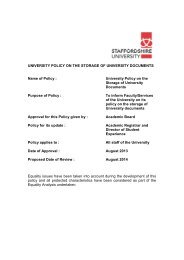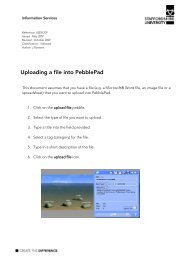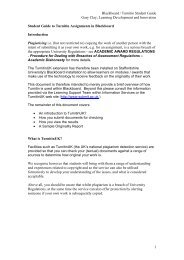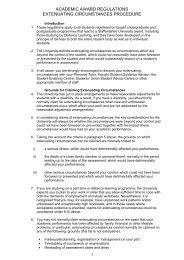PLANTAR FOOT PRESSURE OF LOWER LEG AMPUTEES ...
PLANTAR FOOT PRESSURE OF LOWER LEG AMPUTEES ...
PLANTAR FOOT PRESSURE OF LOWER LEG AMPUTEES ...
You also want an ePaper? Increase the reach of your titles
YUMPU automatically turns print PDFs into web optimized ePapers that Google loves.
RESULTS AND DISCUSSION<br />
As expected the pressure patterns of the prosthetic leg differed significantly from the<br />
remaining leg for most variables and measuring sites, during gait as during running (table 1). It<br />
is, however, remarkable that peak heel pressures show no differences during gait. This<br />
confirms the results from Veves et al (1992) concerning the peak pressures of non-diabetic<br />
amputees for gait. But with increasing speed, as during jogging, the normal foot seems to<br />
accept higher peak loads than the prosthetic foot. Also the build up of pressure (load rate) is<br />
always much higher for the normal heel. This may be due to the dominant presence of the<br />
compliant Flex-Foot, which is known for its highly efficient return of stored energy during<br />
heel impact (Czernieckl, Gitter and Munro, 1991).<br />
As for the forefoot and in contrast with the stabilizing thrust being on the first metatarsal<br />
head in the normal foot, the prosthetic forefoot bears weight centrally. The maximal pressure<br />
under the forefoot is about the same for both feet, but the prosthetic forefoot shows a higher<br />
loading rate, probably due to its rigid metal structure.<br />
WALKING<br />
RUNNING<br />
%<br />
contact<br />
time<br />
Pmax<br />
(N/cm 2 )<br />
%<br />
load<br />
time<br />
load rate<br />
(N/cm 2 /ms)<br />
%<br />
contact<br />
time<br />
Pmax<br />
(N/cm 2 )<br />
%<br />
load<br />
time<br />
load rate<br />
(N/cm 2 /ms)<br />
HM n 45 ± 8 69 ± 20 12 ± 7 2.89 ± 1.33 49 ± 5 93 ± 33 12 ± 4 7.64 ± 5.10<br />
p 42 ± 13 64 ± 29 27 ± 9 0.99 ± 0.47 39 ± 18 66 ± 39 35 ± 9 1.95 ± 0.98<br />
HL n 45 ± 8 60 ± 22 13 ± 7 2.62 ± 1.87 48 ± 5 88 ± 34 10 ± 4 8.78 ± 6.14<br />
p 43 ± 13 61 ± 30 30 ± 8 0.77 ± 0.38 40 ± 17 66 ± 43 36 ± 8 1.89 ± 1.09<br />
M1 n 76 ± 7 40 ± 24 82 ± 6 0.09 ± 0.05 75 ± 6 55 ± 28 63 ± 10 0.44 ± 0.25<br />
p 61 ± 11 27 ± 9 68 ± 11 0.10 ± 0.04 63 ± 12 37 ± 17 59 ± 10 0.39 ± 0.23<br />
M3 n 79 ± 5 30 ± 13 81 ± 5 0.06 ± 0.02 75 ± 8 35 ± 9 64 ± 4 0.25 ± 0.09<br />
p 66 ± 9 43 ± 14 70 ± 12 0.15 ± 0.05 68 ± 12 62 ± 24 64 ± 9 0.54 ± 0.27<br />
M5 n 66 ± 9 13 ± 8 66 ± 13 0.04 ± 0.02 60± 9 22 ± 12 64 ± 11 0.21 ± 0.11<br />
p 63 ± 11 27 ± 8 68 ± 12 0.09 ± 0.04 59± 18 33 ± 14 62 ± 13 0.41 ± 0.42<br />
T1 n 56 ± 17 40 ± 21 74 ± 7 0.15 ± 0.06 74 ± 11 45 ± 26 62 ± 10 0.36 ± 0.20<br />
p 29 ± 18 47 ± 34 75 ± 9 0.32 ± 0.15 37 ± 19 33 ± 30 64 ± 10 0.46 ± 0.33<br />
Table 1: Mean and standard deviations of the plantar pressure variables of the prosthetic (=p)<br />
and the normal (n) foot for walking and running (bold figures indicate a significant difference<br />
between both means with p

















